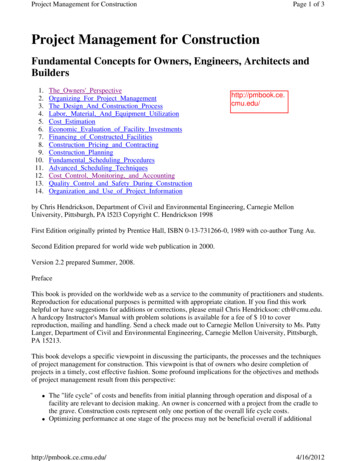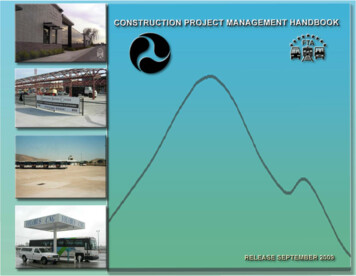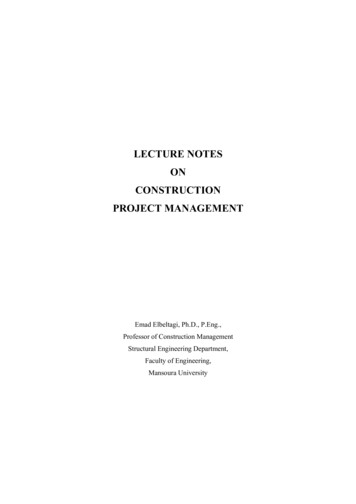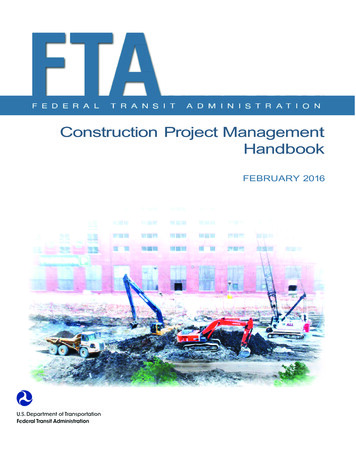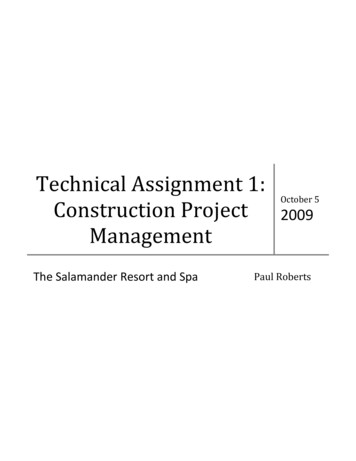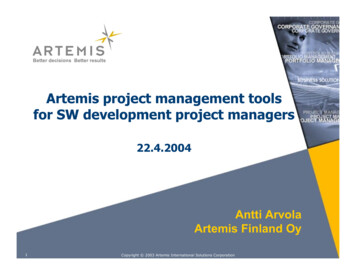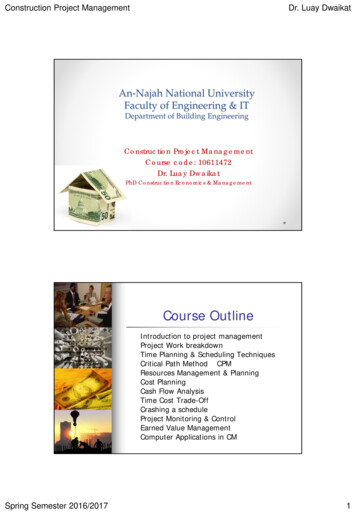
Transcription
Construction Project ManagementDr. Luay DwaikatAn-Najah National UniversityFaculty of Engineering & ITDepartment of Building EngineeringConstruction Project ManagementCourse code: 10611472Dr. Luay DwaikatPhD Construction Economics & ManagementCourse Outline Spring Semester 2016/2017Introduction to project managementProject Work breakdownTime Planning & Scheduling TechniquesCritical Path Method – CPMResources Management & PlanningCost PlanningCash Flow AnalysisTime Cost Trade-OffCrashing a scheduleProject Monitoring & ControlEarned Value ManagementComputer Applications in CM1
Construction Project ManagementDr. Luay DwaikatGrading System 1st exam2nd examFinal exam25 %25 %50 %Hope You SuccessText Book & ReferencesText Book: Hinze, J.W., 2011. Construction Planning andScheduling, 4th edition. Pearson Prentice Hall, NewJersy, USAReferences: Spring Semester 2016/2017Mubarak, S., 2010. Construction Project Scheduling and Control,2nd edition. John Wiley & Sons, Inc, Hoboken, New JerseyPMI, 2013. A guide to the project management body ofknowledge (PMBOK guide), 5th ed. Project Management Institute,Inc., Pennsylvania, USAPMI, 2011. Practice Standard for Earned Value Management, 2nded. Project Management Institute, Inc, Pennsylvania, USA2
Construction Project ManagementDr. Luay DwaikatCommunication &Contact You can use the Zagel system topost your comments andenquiries in the discussionforum.Frequently check the Zagelsystem to find my assignments .Before we start Spring Semester 2016/2017Attend the class on time.Switch off your mobile.Stop the side talks.Be a smart listener.Use your analytical skills.Question every piece ofinformation you acquire.3
Construction Project ManagementDr. Luay DwaikatWhat is a Project? A project is defined as a temporaryendeavor (effort) undertaken to create aunique product or service. Has a definitebeginning and a definite end.Project Characteristics TemporaryUniquedefinite beginning and a definite endConsumes resourcesSpring Semester 2016/20174
Construction Project ManagementDr. Luay DwaikatExamples of projects include: Developing a new product or service.Designing a new transportation vehicle.Constructing a building or facility.Running a campaign for political office.Implementing a new business procedure orprocess.What is Project Management? Project management is the application ofknowledge, skills, tools and techniques to projectactivities in order to meet or exceed stakeholderneeds and expectations from a project.Project management is the planning,organizing, directing, and controlling of companyresources for a relatively short-term objective thathas been established to complete specific goalsand objectives.Spring Semester 2016/20175
Construction Project ManagementDr. Luay DwaikatManagement Functions Planning Organizing Staffing Directing ControllingWhat are the stakeholder needs?competing demands among: time, cost, and quality. Identified requirements (needs) andunidentified requirements (expectations).Spring Semester 2016/20176
Construction Project ManagementDr. Luay DwaikatProject Management Components ScopeTimeCostQualityHuman ResourceCommunicationsRiskProcurementIn construction Project Management is the sum of allactivities such as Planning,organising,implementing and controlling aproject in order to meet the client’sexpectation from start to finish withinthe planned period, budget andquality.”Spring Semester 2016/20177
Construction Project ManagementDr. Luay DwaikatProject Constraints Constraints triangle:TimeCostQualityWhy a Project Fails? Unclear project objectivesUnrealistic expectationsRisk not identifiedInadequate planning & co-ordinationResources are not availableLow productivityWeak project & technical managementSpring Semester 2016/20178
Construction Project ManagementDr. Luay DwaikatWhy a Project Fails? Ineffective project organizationInadequate quality systemsInappropriate management control systemPoor team co-ordinationCONSTRUCTION PROJECTSSpring Semester 2016/20179
Construction Project ManagementDr. Luay DwaikatProject life cycle – Owner Perspective1)2)3)4)Pre t1) Pre constructionThis stage includes the following phases:1)2)3)4)conceptual planningschematic designdesign developmentcontract documentsSpring Semester 2016/201710
Construction Project ManagementDr. Luay Dwaikat2) Procurement Also known as award or biding phaseThe project formally transits from design intoconstructionThis stage begins with a public advertisement for allinterested bidders or an invitation for specific biddersIn fast-track projects, this phase overlaps with thedesign phaseIt is very important stage to select highly qualifiedcontractors.is not wise to select the under-bid contractors3) Construction/Execution The actual physical construction of the projectThis stage takes the project from procurementthrough the final completionIt is the time where the bulk of the owner’sfunds will be spentIt is the outcome of all previous stages (i.e.,good preparation means smooth construction)Changes during construction may hinder theprogress of the projectSpring Semester 2016/201711
Construction Project ManagementDr. Luay Dwaikat4) Close-out Transition from design and construction to the actual use ofthe constructed facilityIn this stage, the management team must providedocumentation, shop drawings, as-built drawings, andoperation manuals to the owner organization (as-builtdrawings are the original contract drawings adjusted toreflect all the changes that occurred)Assessment of the project team’s performance is crucial inthis stage for avoiding mistakes in the future.Actual activity costs and durations should be recorded andcompared with that was planned. This will serve as thebasis for the estimating and scheduling of future projectsCONSTRUCTION PLANNING ANDSCHEDULINGRef.Hinze, J.W., 2011. Construction Planningand Scheduling, 4th edition. PearsonPrentice Hall, New Jersy, USASpring Semester 2016/201712
Construction Project ManagementDr. Luay DwaikatPlanning The road to project failure is paved withpoor plansPLANNING: Influencing the future bymaking decisions todaybased on missions, needs andobjectives. It is an art not science.Planning is NOT a one time activitySpring Semester 2016/201713
Construction Project ManagementDr. Luay DwaikatCategories of planning: TimeCostResourcesQualityContingencyTime Planning When to start when to finish Time plans will be transformed to schedule(time scale)Spring Semester 2016/201714
Construction Project ManagementDr. Luay DwaikatTime planning steps1) Divide project into component parts2) Sequencing component parts in order ofaccomplishment3) Assign durations to each componentpartCost Planning Allocating direct and indirect costs to the projectcomponents Expenditure/revenue ( cost / schedule integration)Spring Semester 2016/201715
Construction Project ManagementDr. Luay DwaikatResources Planning Construction Resources includes: moneyMaterialHuman resourcesEquipments and tools Check if the needed resources are available or NOT. Eliminate idle time. Resources should be planned considering the budget. Attention to critical resources for project success Quality Planning what is the minimum accepted quality? Should I exceed the required quality? How can I achieve this quality?Spring Semester 2016/201716
Construction Project ManagementDr. Luay DwaikatContingency (Risk) Planning Planning for variability and uncertainty“What if” planning to include items subjectto variability which are significantly impactproject cost and timeControl The heart of the project management system is CONTROLLINGthe execution of the works. The purpose of this control is to determine and predictdeviations in a project so corrective actions can be taken. The milestones of the control process are as follows: To determine the aimTo evaluate the actual results and to compare to the plannedSpring Semester 2016/201717
Construction Project ManagementDr. Luay DwaikatControl İt defines the quality of themanagementConstruction schedulingSpring Semester 2016/201718
Construction Project ManagementDr. Luay DwaikatConstruction scheduling To be able to build up a successful schedule. Youneed to:1) Define activities2) Establish activities relationships3) assign durations to activities4) resources and costs allocation5) calculate early and late start/finish times6) calculate float values and identify the criticalpathConstruction activity Anything that must be accomplished inorder to complete the project may beconsidered as activity.Consumes time and resources.Activity duration: is the estimated timerequired to complete an activity.Spring Semester 2016/201719
Construction Project ManagementDr. Luay DwaikatProject BreakdownWork Breakdown StructureIntegrating Planning Integration of time, cost and resourceplanning against the same basic structure(WBS) Resource budgeting against time Cost budgets plotted against timeSpring Semester 2016/201720
Construction Project ManagementDr. Luay DwaikatThousands of tasks The psychologists say our brains cannormally comprehend around 7-9 itemssimultaneously.So, divide and subdivide the project.The WBS(Work Breakdown Structure) It is used to break down the project fromone main and relatively big entity intosmaller, defined, manageable andcontrollable units, usually called workgroups (packages) or tasks, or, at the finestlevel of detail (which is undesirable)activitiesSpring Semester 2016/201721
Construction Project ManagementDr. Luay DwaikatTake care!!! The deeper you go into the lower levels ofthe WBS, the more detailed knowledgeyou’ll need to know.See next slide.Level 1House1.0Level 2Level 3StructureMechanicalElectrical1.11.21.3Sub – str.Super str.HVACPlumbing1.1.11.1.21.2.11.2.2Earth 1.1.1.2BlindingfootingsTie beamsGround slabSpring Semester 2016/2017Str. elements1.1.2.1Finishing1.1.2.2columnsbeamsRoof slabPlasterTilepaintingDoors &windowsLevel 4Level 522
Construction Project ManagementDr. Luay DwaikatThe WBS(Work Breakdown Structure)1.0 house1.1 structure1.1.1 sub – structure1.1.1.1 earth workE10 excavationE20 backfillingE30 leveling1.1.1.2 foundationF10 blindingF20 footingsF30 tie beamsF40 ground slab1.1.2 super structure1.1.2.1 structural elementsCS10 columnsCS 20 beamsCS 30 roof slab1.1.2.2 finishingC10 plasterC20 tileC30 paintingC40 doors & windows1.2 mechanical1.2.1 HVACThe WBS it is a major task to undo.Why? Because cost collections begins at a WBSelement,Spring Semester 2016/201723
Construction Project ManagementDr. Luay DwaikatConclusion The work breakdown structure defines theproduct elements (work packages).And their interrelations to each other andto the product.The WBS mostly ends with project tasks.Using the tasks you can extract project’sactivities.Construction schedulingSpring Semester 2016/201724
Construction Project ManagementDr. Luay DwaikatConstruction scheduling To be able to build up a successful schedule. Youneed to:1) Define activities2) Establish activities relationships3) assign durations to activities4) resources and costs allocation5) calculate early and late start/finish times6) calculate float values and identify the criticalpathConstruction activities Anything that must be accomplished inorder to complete the project may beconsidered as activity.Spring Semester 2016/201725
Construction Project ManagementDr. Luay DwaikatActivities Duration Activity duration: is the estimated timerequired to complete an activity.Activity duration mainly calculated basedon:1) the quantities take off.2) labor or machines productivity rates.Activities Duration Durations could be estimated byexperience. ( previous similar jobs)If experience not available, othersexperience could be utilized.If not, handbooks of productivity rates areavailable provide the required information.Spring Semester 2016/201726
Construction Project ManagementDr. Luay DwaikatActivities Duration Activity duration can be calculated asfollows:quantity of the work crew hoursqty / crew hour qty / crew hour is the productivity rate. Time unit is hours could be changed to working days.Activities Duration Example: assume that you have a floor tile area of 600 M2 , and theproductivity rate of a tile mason and one helper is 1.5 M2 / hour.By applying the previous equation:600M2 400 hours1.5 M2 / hIf the time unit is working day ( 8 hours) :400 hours 50 days8 hoursSpring Semester 2016/201727
Construction Project ManagementDr. Luay DwaikatActivities DurationBy using two tile masons and two helpers:600 M2 200 hours2 x 1.5 M2 / h If the time unit is working day ( 8 hours) :200 hours 25 days8 hoursActivities DurationBy using 3 tile masons and 3 helpers:600 M2 133.3 hours 134 hours3 x 1.5 M2/hIf the time unit is working day ( 8 hours) :134 hours 16.75 days 17 days8 hoursTime preferably should be rounded up :Spring Semester 2016/201728
Construction Project ManagementDr. Luay DwaikatActivities DurationBy using 4 tile masons and 4 helpers:600 M2 100 hours4 x 1.5 M2 / h If the time unit is working day ( 8 hours) :100 hours 12.5 days 13 days8 hoursActivities Duration Assume in the previous example that this activity is critical and should befinished within 5 days:If the working day is 8 hours :5 days X 8 hours 40 hours Apply the equation :600X M2 40 hoursX 15 M2 / h is the productivity rateThe crew number should be 15 / 1.5 10 gangsSpring Semester 2016/201729
Construction Project ManagementDr. Luay DwaikatActivities Duration Vs. Direct Cost Having defined an activity duration, itmeans that the planner have alreadydefined the number of resources that willbe employed in a particular activity.Knowing activity duration and resourcesemployed, it is simple to estimate theactivity direct cost.example If the daily production rate for a crew thatworks in an activity is 175 units/day andthe total crew cost per day is 100 . Thematerial unit cost is 1 .a. Calculate the time and cost it takes thecrew to finish 1400 unitsb. Calculate the total unit cost.Spring Semester 2016/201730
Construction Project ManagementDr. Luay DwaikatSolution Activity duration Qty / crew output 1400 / 175 8 daysCrew cost 8 days * 100 /day 800 Material cost 1400 unit * 1 1400 Total direct cost Labor cost Material Cost 800 1400 2200 Total Unit cost total cost / quantity 2200 / 1400 unit 1.57 /unitSome Factors that affects Duration1)2)3)4)5)6)7)8)9)Weather.Availability and training of Labor.Required qualityFamiliarity with the work.Quality of workmanship specified.Quality of management/supervision.Size and completion date of project.Length and incidence of holidays.Physical constraints of the site. Such as access, size,storage space and etc.Spring Semester 2016/201731
Construction Project ManagementDr. Luay DwaikatTypes of Construction activities1)2)3)production/construction activity.Procurement activity.Management activity.production/construction. production/construction activities:activities that relate directly to the physicalefforts of creating the project.E.g. Concrete work, plaster, tile and etc.Usually use traditional resources, labor,material and equipments.Spring Semester 2016/201732
Construction Project ManagementDr. Luay DwaikatProcurement. Procurement activities: Influence the start of production activities. These activitiesinclude arranging for the acquisition of materials, money,equipment and manpower.Should be incorporated in the Schedule ifthey are long or special orders.Management. Management activities: support andadministrative tasks.Such as, preparing inspection reports,obtain shop drawing approvals. Trackingsubmittal approval and tests.Spring Semester 2016/201733
Construction Project ManagementDr. Luay DwaikatConstruction Scheduling methodsConstruction scheduling What is the difference between a scheduleand a Plan?The schedule: putting the plan on timescale.Schedule: what would be done in a certaintime and who will be working.Spring Semester 2016/201734
Construction Project ManagementDr. Luay DwaikatMost Common Scheduling methods common scheduling methodologies:Bar Chart (Gantt Chart)Critical Path Method (CPM)PERT (program Evaluation & ReviewTechnique) Linear Scheduling Method (LSM)Bar Chart or Gantt chart Bar chart is a collection of activitieslisted vertically, and the horizontalscale represents the time.First applied by HENRY GANTT in 1917Spring Semester 2016/201735
Construction Project ManagementDr. Luay DwaikatBar Chart or Gantt chartAActivityBCDEF12345Time (weeks)678Advantages of Bar / Gantt Chart1)Plan, schedule and progress are all depicted graphically ona single chart2)Easily read3)Provides simple way to schedule small projects4)5)Provides summary display of more detailed plans andschedules.Best used for management briefingsSpring Semester 2016/201736
Construction Project ManagementDr. Luay DwaikatBar Chart or Gantt chartCurrent timeAActivityBCDEF12345Time (weeks)678Disadvantages of Bar / Gantt Chart1)2)3)Activity dependencies cannot adequatelybe shown.Difficult to determine how activityprogress delays affect project completion.Difficult to establish and maintain for largeprojectsSpring Semester 2016/201737
Construction Project ManagementDr. Luay DwaikatCritical Path Method (CPM) Two basic methods of analysis:1) ADM -- Arrow Diagramming Method orActivity On Arrow (AOA) or I-J Method2) PDM -- Precedence Diagramming MethodActivity On Node (AON) Method1) ADM -- Arrow Diagramming Method Activity on Arrow (AoA) or noun as i – j method In The ADM the activity represented by an arrow. The arrow head represents the relation withother activities (interdependency). it looks like the following figureSpring Semester 2016/201738
Construction Project ManagementDr. Luay DwaikatADM -- Arrow DiagrammingMethodEvent iEvent jexcavationij7The Excavation activity OR activity i - j with duration of 7 (time unit)ADM -- Arrow Diagramming Method Linear sequencing Summation of all activities durations total duration10Form work211Steel rebar112Pour concrete113Deshuttering147Total Duration 2 1 1 7 11 daysSpring Semester 2016/201739
Construction Project ManagementDr. Luay DwaikatADM -- Arrow DiagrammingMethod1011walls plaster14151213ADM -- Arrow rk45erectFormworkerectFormwork653Spring Semester 2016/201740
Construction Project ManagementDr. Luay DwaikatDummy activitieselectricalconduit1Build wall2plumbing3Wall Plaster134Joinery 1stfixingsDummy activities Dummyactivity has ZERO duration and Does NOT consume resources.31Build wall2plumbing5Plaster wall13641) Dummies help in activities identificationSpring Semester 2016/201741
Construction Project ManagementDr. Luay DwaikatDummy activities If activity R follows P and activity S follows TPR11ST does the above figure depict the statement.?What about thisPTSpring Semester 2016/20171211RS42
Construction Project ManagementDr. Luay DwaikatDummy activities If the method statement changed that activity S isdependent on both activities P & T. and activity Rdependent on P only.PTR12S112) Dummy activities help to maintain the logic of the networkExercise: draw arrow diagram for the following project.Spring Semester 4B&CF2BG1DH4F&EI2FJ4G&HK4I&HL1K&J43
Construction Project Management The10ADr. Luay DwaikatArrow Network will be:B152F252I405522C 4K42027E354DH45604J130GL1654501Network calculations Forward Pass: deals with the early start and early finish Backward Pass: deals with the late start and late finishSpring Semester 2016/201744
Construction Project ManagementDr. Luay DwaikatAn activity time values ES: the earliest time that an activity can start as determinedby the latest of the early finish times of all immediatelypreceding activities. EF: the earliest time that an activity can finish, determined byEF ES D LS : the latest time that an activity can start without delayingthe project completion. LS LF – D. LF : the latest time that an activity can be finished withoutdelaying the project completion, as determined by theearliest of the late starts of the immediately succeedingactivities.ExampleBeginning of the day convention112A12386C44E25EF ES Duration3Forward Pass calculations to determine the early start and early finish datesSpring Semester 2016/201745
Construction Project ManagementDr. Luay DwaikatExample12112A12C4686844E25LS LF – Duration33Backward pass calculations to determine the late start and late finish datesExample1610171610171A5283C44E75LS LF – Duration3Backward pass calculations to determine the late start and late finish datesSpring Semester 2016/201746
Construction Project ManagementDr. Luay DwaikatTabular 24624668BCDETotal Float (TF)TF LS – ES OR LF - 466801010BCDETF: the amount of time that an activity can be delayed before it impacts the project completion.Spring Semester 2016/201747
Construction Project ManagementDr. Luay DwaikatES – EF ScheduleActivityABCDE12345678dayEarly Times Schedule (ES – EF)LS – LF ScheduleActivityABCDE12345678dayLate Times Schedule (LS – LF)Spring Semester 2016/201748
Construction Project ManagementDr. Luay DwaikatEarly / Late times scheduleActivityABCDE12435678dayBoth Early / Late Times ScheduleCritical Path126812681A1243C44E25LS LF – Duration3The critical path: is the longest path in the network and the shortest possible duration.Spring Semester 2016/201749
Construction Project Management Forward11Pass calculations (ES, EF)3ADr. Luay Dwaikat5B227F32C 415I9774EH74D8111215G5194J1K415116102220L113481 backward11Pass calculations (LS, LF)3A7B2211F32C ring Semester 2016/201750
Construction Project Management Determining111the Critical Path33ADr. Luay Dwaikat75B22117F32I977415151111E6H74D1102277C 4151511124148J1515G5K 191942020L113481 Determining111the Critical Path33A75B22117F32I977461E7HK 19194111241485151511114D102277C 41515J1515G2020L113481The Critical path passes through activities where TF 0Spring Semester 2016/201751
Construction Project ManagementDr. Luay DwaikatEarly 257G189H41115I279J41519K41519L11920Bar / Gantt chart Early Start / FinishEF ES DActivityABCDEFGHIJKL2Spring Semester 2016/201746810Day121416182052
Construction Project ManagementDr. Luay DwaikatEarly / Late 415191519K415191519L119201920Bar / Gantt Chart Late Start / FinishLS LF - DActivityABCDEFGHIJKL2Spring Semester 2016/201746810Day121416182053
Construction Project ManagementDr. Luay DwaikatTotal Float (TF): The amount of time an activity can be delayed withoutdelaying the overall project completion.TF LF – EF LS - 3156J4151915190K4151915190L1192019200Bar / Gantt of the previous networkABCDEFGHIJKL2Spring Semester 2016/201746810Day121416182054
Construction Project ManagementDr. Luay Dwaikat2) PDM Precedence Diagramming MethodActivity On Node (AON) Method PDM is the primary method in use today.Used by most of the computer software. MS ProjectPrimaveraSure TrackPDM Precedence Diagramming Method The PDM depicts activities as NODES in thenetwork linked with logic lines.The node representing the activity.Arrow representing relationship /dependencyPDM should be red left to rightSpring Semester 2016/201755
Construction Project ManagementDr. Luay DwaikatPDM Precedence Diagramming Method PDM looks like the following:Activity AActivity B The shape of the node could be any shapePDM vs. ADMADMA1PDMC23ACBD B4Spring Semester 2016/2017D5656
Construction Project ManagementDr. Luay DwaikatPDM vs. ADMADMPDMB3BA21C4 ACD5DExercise Draw a PDM for the following activities.ActivityABCEFGHDSpring Semester 2016/2017ActivityDescriptionLay outExcavationplace formworkpurchase steelbend steelplace steelorder concreteplace concretepredecessor-AB-EC,F-G,H57
Construction Project ManagementDr. Luay DwaikatThe PDM will be:HABDCEFGExercise Draw a PDM for the following activities.Spring Semester G58
Construction Project ManagementDr. Luay DwaikatSolutionABDFCEGHActivities Relationships Types of relations between activities:1)2)3)4)Spring Semester 2016/2017Finish to start – FSStart to Finish – SFFinish to Finish – FFStart to Start - SS59
Construction Project ManagementDr. Luay Dwaikat1) Finish to start – FS Relationship The traditional relationship betweenactivities.Implies that the preceding activity mustfinish before the succeeding activities canstart.Example: the plaster must be finishedbefore the tile can start.Finish to start with delay relationshipPour concrete1 dayDeshuttering2 daysDeshuttering should start after 28 days of concrete curingPour concrete1 dayFS/28Deshuttering2 days28 days is delay time or LAG means that: deshuttering can start 28 days afterConcrete has been pouredSpring Semester 2016/201760
Construction Project ManagementDr. Luay DwaikatFinish to start with delay relationship3) Star to Finish – SF relationship Appear illogical or irrational.Typically used with delay time OR LAG.The following examples proofs that it is logical.Spring Semester 2016/201761
Construction Project ManagementDr. Luay Dwaikat2) Star to Finish – SF relationshipsteelErect formworkPour concretereinforcementSF/5Order concreteThe concrete supplier stipulates 5 days order before delivery.3) Finish to Finish – FF relationship Both activities must finish at the same time.Can be used where activities can overlap to acertain limit.Spring Semester 2016/201762
Construction Project ManagementDr. Luay DwaikatFinish to Finish – FF relationshipSet flagpoleIn the holePosition flagpoleIn the holeFFBackfillholeFinish to Finish with delay relationshipErectscaffoldingRemoveOld paintFF/1sandingFF/2paintingSpring Semester 2016/2017inspectDismantlescaffolding63
Construction Project ManagementDr. Luay Dwaikat4) Start to Start – SS relationship Bothactivities must start at the same time.Start to Start – SS relationshipClean surfaceSpread groutSSSet tileSpring Semester 2016/2017Clean floor area64
Construction Project ManagementDr. Luay DwaikatPrecedence Network Calculations the basic information that should becalculated in the precedence network are:1)2)3)4)5)6)Early activity start (ES)Early activity finish (EF)Late activity start (LS)Late activity finish (LF)Free Float (FF)Total Float (TF)Precedence Network Calculations ES: the earliest time that an activity can start asdetermined by the latest of the early finish times of allimmediately preceding activities.EF: the earliest time that an activity can finish,determined by EF ES DLS : the latest time that an activity can start withoutdelaying the project completion.LS LF – D.LF : the latest time that an activity can be finishedwithout delaying the project completion, as determined bythe earliest of the late starts of the immediatelysucceeding activities.Spring Semester 2016/201765
Construction Project ManagementDr. Luay DwaikatPrecedence Network Calculations FF: the amount of time that an activity can bedelayed before it impacts the start of anysucceeding activities.TF: the amount of time that an activity can bedelayed before it impacts the project completion.Lag: the amount of time that exists between theEF of an activity and the ES of a specifiedsucceeding activity.LAGAB ESB - EFAPrecedence Network Calculations The previously mentioned information canbe illustrated in the activity nod in thenetwork:Activity descriptionESEFSpring Semester 2016/2017DurationFFTFLSLF66
Construction Project ManagementDr. Luay DwaikatPrecedence Network CalculationsReminder: The manual calculationsassumes that the relationships betweenactivities are Finish to Start (FS) Type. Precedence Network Calculations1) Forward pass calculations4) Backward pass calculations5) Calculate total Float (TF LS – ES OR LF – EF)A120B010122110D02110 111690160 16204C7500E0573 1011200 202110200 213G010113 141740H0164502F011563143 202) Calculate the Lag ( LAGAB ESB - EFAES3) Calculate the Free Float (FF) FF min. LAGSpring Semester 2016/2017Dur.LSEF FF TF LF67
Construction Project ManagementDr. Luay DwaikatPrecedence Network Calculations6) Determine the Critical PathA1210B00122112110 111690D011160 162050427E0573 10115016200 20214010200 213G010113 141740H050CF063143 20The critical path passes through the critical activities where TF 0ESDur.LSEF FF TF LFBar / Gantt chart Early Start / FinishEF ES DActivityABCDEFGH2Spring Semester 2016/201746810Time121416182068
Construction Project ManagementDr. Luay DwaikatBar / Gantt chart Late Start / FinishLS LF - DActivityABCDEFGH246810Time121416182014161820Bar / Gantt chartActivityABCDEFGH2Spring Semester 2016/201746810Time1269
Construction Project ManagementDr. Luay DwaikatExercise1) Forward pass calculations4) Backward pass 1171117711117172580172825291280299172) Calculate the Lag ( LAGAB ESB - EFALSDur.Floor tile1698ES60sub-frames000114028plaster00128 00plumbingBlock work1589Waterproofing253258EF FF TF LF3) Calculate the Free Float (FF) FF min. LAG6) Determine the Critical Path5) Calculate total Float (TF LS – ES OR LF – 17sub-framesESDur.190Floor tile00 1170 28
Construction Project Management Dr. Luay Dwaikat Spring Semester 2016/2017 2 Grading System 1st exam 25 % 2nd exam 25 % Final exam 50 % Hope You Success Text Book & References Text Book: Hinze, J.W., 2011. Construction Planning and Scheduling, 4th edition

